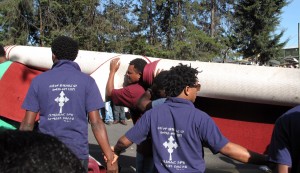What I should be doing tonight: writing yet another recommendation letter, working on a big grant proposal, revising a manuscript, outlining an invited paper, putting together a new professional talk. I fondly long for my first trip to Africa, when computers and the internet were extremely difficult to access, it was ok to be out of contact for months at a time, and you had no responsibilities other than staying alive and eventually returning to the US…
What I am going to do tonight: watch football.
Those of you who know me well will be surprised to that it is not American football I am watching (although I’m still optimistic about finding someplace to watch the Super Bowl). I’ve finally joined the rest of the world in appreciating the sport of football that is actually played with the feet (i.e. soccer, to the American audience). In this case, it’s the Africa Cup, the yearly tournament of 16 nations. Four nations per group, with two teams advancing to the next round, then single elimination to the final. This year, the tournament is in South Africa, and Ethiopia is participating for the first time in over 30 years!
It’s undeniable that having a vested interest in a team makes watching a sport much more interesting. There’s a parallel between my feelings about the Africa Cup and March Madness – you fill out your bracket, and all of a sudden you go from never having heard of Butler to cheering for them like your life depends on it, or at least two points and an upset bonus in your pool. I don’t have any money riding on these games, and my own national pride is not at stake, but living here and watching how excited this football-crazed nation is, it’s impossible not to be anxious before and during the games and put all your energy into cheering for the Waliyas (name of the men’s national team, meaning “Ibex.” On a side note, it should be a delight to paleo-aficionados everywhere that the women’s national team is named “Lucy”).
Although Ethiopia is a football-crazy country, the national team has been atrocious for as long as most people can remember. My contemporaries were not even born the last time Ethiopia played in the Africa Cup. Before the start of the second game, Gelachew explained to me how nervous he was. I could relate; his words echoed those I would have spoken in the build up to the 2007 Super Bowl, the first time my beloved Bears made it since I was four years old. Unlike my sister, I do not have vivid memories from such a young age, so I could just as well not have been born the last time da Bears were in the Game. And this is one of the things I love so much about sports – it brings people together, allows those of very different backgrounds to feel the same emotions, and reminds us that despite our differences, we humans are all fundamentally the same.
During the first game, versus last year’s champ Zambia, an older man sitting next to me said that this was the first goal they’d scored since he was in 4th grade. And, wow, did the crowd at the bar I was in, and in Addis in general, go crazy after that first goal! That game ended in a 1-1 draw, which was especially spectacular since the Ethiopian goalie was sent off and the Waliyas had to play a man down for more than half the game. Mesfin and I were watching in Bole, the hip part of town, and the streets were crazy afterwards – cars gridlocked and honking, people running around the cars whistling, yelling, and singing, huge crowds around Edna Mall watching replays on the big outdoor screen. Sadly, game two did not end as well – when the Burkina Faso goalie got sent off early in the second half with Ethiopia down 1-0, and the crowd went wild, but in the half hour that followed, Ethiopia gave up three more goals for an embarrassing 4-0 defeat. Not to make excuses or anything, but Ethiopia did lose their best player to injury early in the game. Tonight is the last match of pool play, and Ethiopia needs to beat Nigeria and have Zambia lose to Burkina Faso to advance. Tall order, but Roze and I will be in the crowd, hoping for the best!
And, since you’re not a real fan unless you’re wearing your allegiance, my friend Mesfin surprised me with a jersey before the second game. I shrieked in delight, and changed as soon as we got to the walled off parking lot where there was a modicum of privacy. On a humorous note, it is size XXXL, but I’m sure that’s because it’s actually a children’s jersey. I’m not that fat, even by Ethiopian standards, right? Proudly wearing it again today and looking forward to the game tonight!!!















